Motor neurone Study guides, Revision notes & Summaries
Looking for the best study guides, study notes and summaries about Motor neurone? On this page you'll find 144 study documents about Motor neurone.
Page 3 out of 144 results
Sort by
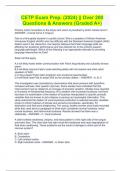
-
CETP Exam Prep. (2024) || Over 200 Questions & Answers (Graded A+)
- Exam (elaborations) • 55 pages • 2024
- Available in package deal
-
- £13.75
- + learn more
CETP Exam Prep. (2024) || Over 200 Questions & Answers (Graded A+) CETP Exam Prep. (2024) || Over 200 Questions & Answers (Graded A+) Primary motor innveration to the larynx and velum is provided by which cranial nerve? - ANSWER - Cranial nerve X (Vagus) Fela is a third-grade student in a public school. She is a speaker of African American Vernacular English (AAVE) who has difficulty with the Standard American English (SAE) dialect used in her classroom. Her teacher believes that Fela's ...

-
AQA A Level Biology - Topic 6 - Survival And Response
- Exam (elaborations) • 24 pages • 2024
-
- £9.30
- + learn more
AQA A Level Biology - Topic 6 - Survival And Response What is a stimulus? A change in the environment of an organism What is a tactic response? What is a kinetic response? Directional movement in response to a stimulus Non directional random movement in response to a stimulus What is a positive and negative taxis? Positive taxis- organism moves towards stimulus Negative taxis - organism moves away from stimulus What Are receptors? different types What are effec...
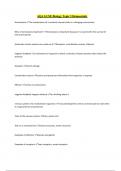
-
AQA GCSE Biology Topic 5 Homeostatis
- Exam (elaborations) • 9 pages • 2024
- Available in package deal
-
- £8.08
- + learn more
AQA GCSE Biology Topic 5 Homeostatis Homeostasis The maintenance of a constant internal state in a changing environment Why is homeostasis important? Homeostasis is important because it is essential for the survival of cells and enzymes Automatic control systems are made up of Receptors, coordination centres, effectors negative feedback a mechanism of response in which a stimulus initiates reactions that reduce the stimulus Receptor Detects change Coordination centre Receives an...
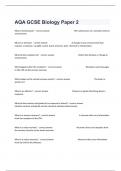
-
AQA GCSE Biology Paper 2 Questions With 100% Verified Guaranteed Answers.
- Exam (elaborations) • 36 pages • 2024
- Available in package deal
-
- £14.15
- + learn more
What is homeostasis? - correct answer The maintenance of a constant internal environment. What is a stimulus? - correct answer A change in your environment than requires a response. e.g Light, sound, touch, pressure, pain, chemical or temperature. What do the receptors do? - correct answer Detect the stimulus or change in environment. What happens ...
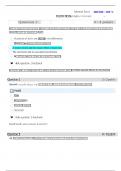
-
BIOL250 Week 12 Unit Exam 4
- Exam (elaborations) • 20 pages • 2023
-
- £28.72
- + learn more
1. Question: Which type of contraction allows a muscle to produce tension without changing the angle of a skeleton joint all moving a load? 2. Question: Mooth muscle tissue can be found in all but which of the following places? 3. Question: All but which of the following are characteristics of aerobic respiration? 4. Question: Which structures of cardiac muscle allows the cells to contract in waves so the heart can both as a pump? 5. Question: Slow oxidative (SO) muscle fibres: 6. Question:...
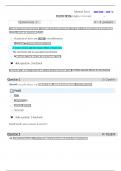
-
BIOL250 Week 12 Unit Exam 4 (50 Questions and Answers) APPU
- Exam (elaborations) • 20 pages • 2023
-
- £24.27
- + learn more
1. Question: Which type of contraction allows a muscle to produce tension without changing the angle of a skeleton joint all moving a load? 2. Question: Mooth muscle tissue can be found in all but which of the following places? 3. Question: All but which of the following are characteristics of aerobic respiration? 4. Question: Which structures of cardiac muscle allows the cells to contract in waves so the heart can both as a pump? 5. Question: Slow oxidative (SO) muscle fibres: 6. Question:...
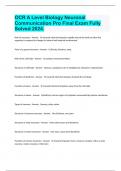
-
OCR A Level Biology Neuronal Communication Pro Final Exam Fully Solved 2024.
- Exam (elaborations) • 6 pages • 2024
- Available in package deal
-
- £6.47
- + learn more
Role of neurones - Answer To transmit electrical impulses rapidly around the body to allow the organism to respond to changes in internal and external environment Parts of a general neurone - Answer Cell body, Dendron, axon, Role of the cell body - Answer To produce neurotransmitters Structure of cell body - Answer Nucleus, cytoplasm, lots of endoplasmic reticulum, mitochondria Function of dendrons - Answer To transmit electrical impulses towards the cell body Function o...
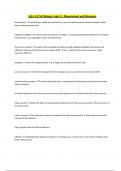
-
AQA GCSE Biology topic 5 - Homeostasis and Response
- Exam (elaborations) • 6 pages • 2024
- Available in package deal
-
- £8.89
- + learn more
AQA GCSE Biology topic 5 - Homeostasis and Response Homeostasis maintaining a stable environment e.g. nervous and hormonal communications, body temp, blood glucose levels. negative feedback A process that counteracts a change - increasing and decreasing levels to maintain homeostasis, e.g. sweating to lower the body temp the nervous system A system that manages the body through negative feedback, hormones and effectors made up of Central nervous system (CNS - brain + spinal cord), se...
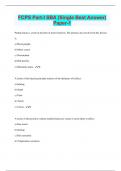
-
FCPS Part-I SBA (Single Best Answer) Paper-1
- Exam (elaborations) • 6 pages • 2024
-
- £8.08
- + learn more
FCPS Part-I SBA (Single Best Answer) Paper-1 Parkinsonism is a known disorder of motor function. The primary area involved in this disease is: a) Basal ganglia b) Motor cortex c) Neostriatum d) Red nucleus e) Substantia nigra - E A lesion of the lateral geniculate nucleus of the thalamus will affect: a) hearing b) Smell c) Taste d) Touch e) Vision - E A lesion of the posterior column-medial lemniscus system is most likely to affect: a) Fine touch b) hearing c) Pain sens...
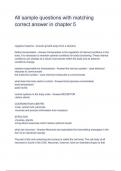
-
All sample questions with matching correct answer in chapter 5
- Exam (elaborations) • 13 pages • 2023
-
- £6.87
- + learn more
negative tropisms - Answer-growth away from a stimulus Define homeostasis - Answer-Homeostasis is the regulation of internal conditions in the body. It is necessary to maintain optimal conditions for body functioning. These internal conditions can change as a result of processes within the body and as external conditions change. systems responsible for homeostasis - Answer-the nervous system - uses electrical impulses to communicate the endocrine system - uses chemical molecules to commun...

£5.50 for your revision notes multiplied by 100 fellow students... Do the math: that's a lot of money! Don't be a thief of your own wallet and start uploading yours now. Discover all about earning on Stuvia


